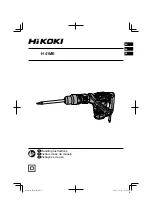
4 ENGLISH
Power tool use and care
1.
Do not force the power tool. Use the correct
power tool for your application.
The correct
power tool will do the job better and safer at the
rate for which it was designed.
2.
Do not use the power tool if the switch does not turn
it on and off.
Any power tool that cannot be controlled
with the switch is dangerous and must be repaired.
3.
Disconnect the plug from the power source
and/or remove the battery pack, if detachable,
from the power tool before making any adjust-
ments, changing accessories, or storing power
tools.
Such preventive safety measures reduce
the risk of starting the power tool accidentally.
4.
Store idle power tools out of the reach of children and
do not allow persons unfamiliar with the power tool
or these instructions to operate the power tool.
Power
tools are dangerous in the hands of untrained users.
5.
Maintain power tools and accessories. Check for
misalignment or binding of moving parts, break-
age of parts and any other condition that may
affect the power tool’s operation. If damaged, have
the power tool repaired before use.
Many accidents
are caused by poorly maintained power tools.
6.
Keep cutting tools sharp and clean.
Properly
maintained cutting tools with sharp cutting edges
are less likely to bind and are easier to control.
7.
Use the power tool, accessories and tool bits
etc. in accordance with these instructions, tak-
ing into account the working conditions and
the work to be performed.
Use of the power tool
for operations different from those intended could
result in a hazardous situation.
8.
Keep handles and grasping surfaces dry, clean
and free from oil and grease.
Slippery handles and
grasping surfaces do not allow for safe handling and
control of the tool in unexpected situations.
9.
When using the tool, do not wear cloth work
gloves which may be entangled.
The entangle-
ment of cloth work gloves in the moving parts may
result in personal injury.
Battery tool use and care
1.
Recharge only with the charger specified by
the manufacturer.
A charger that is suitable for
one type of battery pack may create a risk of fire
when used with another battery pack.
2.
Use power tools only with specifically desig
-
nated battery packs.
Use of any other battery
packs may create a risk of injury and fire.
3.
When battery pack is not in use, keep it away
from other metal objects, like paper clips,
coins, keys, nails, screws or other small metal
objects, that can make a connection from one
terminal to another.
Shorting the battery termi
-
nals together may cause burns or a fire.
4.
Under abusive conditions, liquid may be ejected
from the battery; avoid contact. If contact acci-
dentally occurs, flush with water. If liquid con
-
tacts eyes, additionally seek medical help.
Liquid
ejected from the battery may cause irritation or burns.
5.
Do not use a battery pack or tool that is dam-
aged or modified.
Damaged or modified batteries
may exhibit unpredictable behaviour resulting in
fire, explosion or risk of injury.
6.
Do not expose a battery pack or tool to fire or
excessive temperature.
Exposure to fire or tem
-
perature above 130 °C may cause explosion.
7.
Follow all charging instructions and do not
charge the battery pack or tool outside the
temperature range specified in the instruc
-
tions.
Charging improperly or at temperatures
outside the specified range may damage the
battery and increase the risk of fire.
Service
1.
Have your power tool serviced by a qualified
repair person using only identical replacement
parts.
This will ensure that the safety of the power
tool is maintained.
2.
Never service damaged battery packs.
Service
of battery packs should only be performed by the
manufacturer or authorized service providers.
3.
Follow instruction for lubricating and chang-
ing accessories.
Cordless impact wrench safety
warnings
1.
Hold the power tool by insulated gripping
surfaces, when performing an operation
where the fastener may contact hidden wiring.
Fasteners contacting a "live" wire may make
exposed metal parts of the power tool "live" and
could give the operator an electric shock.
2.
Wear ear protectors.
3.
Check the impact socket carefully for wear,
cracks or damage before installation.
4.
Hold the tool firmly.
5.
Keep hands away from rotating parts.
6.
Always be sure you have a firm footing.
Be sure no one is below when using the tool in
high locations.
7.
The proper fastening torque may differ
depending upon the kind or size of the bolt.
Check the torque with a torque wrench.
SAVE THESE INSTRUCTIONS.
WARNING:
DO NOT let comfort or familiarity
with product (gained from repeated use) replace strict
adherence to safety rules for the subject product.
MISUSE or failure to follow the safety rules stated in this
instruction manual may cause serious personal injury.
Important safety instructions for
battery cartridge
1.
Before using battery cartridge, read all instruc-
tions and cautionary markings on (1) battery
charger, (2) battery, and (3) product using battery.
2.
Do not disassemble battery cartridge.
3.
If operating time has become excessively
shorter, stop operating immediately. It may
result in a risk of overheating, possible burns
and even an explosion.
4.
If electrolyte gets into your eyes, rinse them
out with clear water and seek medical atten-
tion right away. It may result in loss of your
eyesight.
Summary of Contents for DTW180Z
Page 11: ...11 ...






























